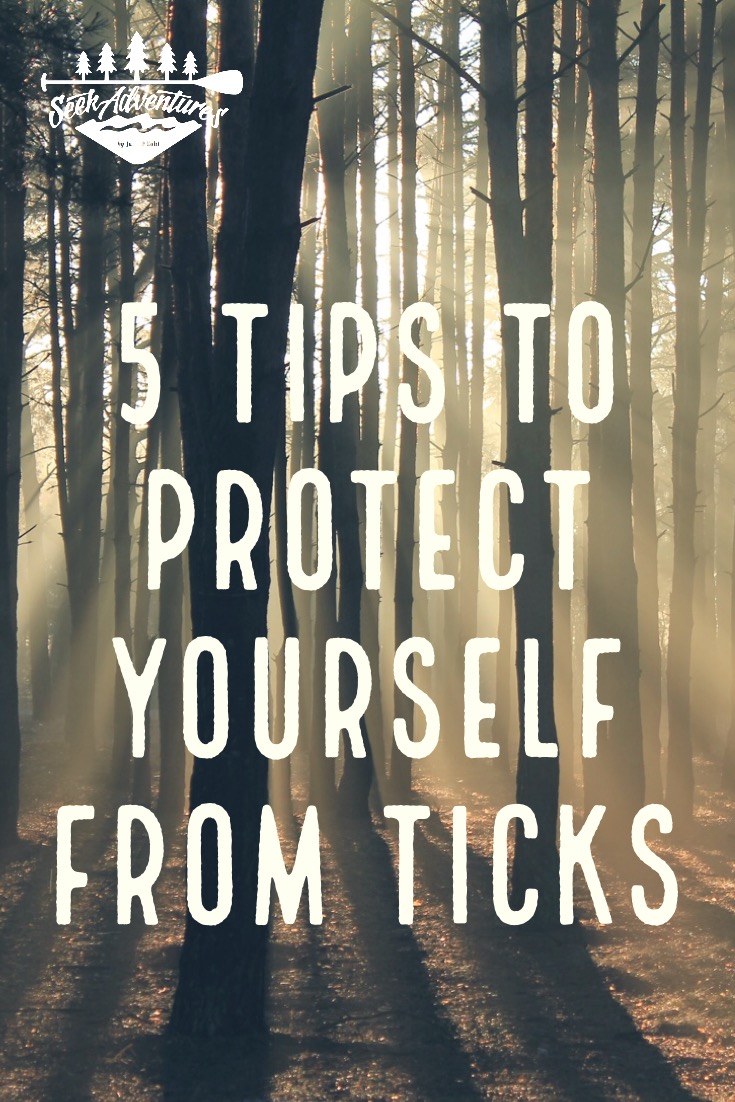If you spend time outdoors, you need to be tick-aware. Ticks carry a variety of diseases, most notably Lyme disease. Ticks infected with the bacterium Borrelia burgdorferi transmit Lyme Disease through a bite wound. Ticks can be a cause for serious concern, especially if you don’t catch them early, as they carry bacteria, viruses and parasites that can lead to illness in humans and pets. Here are 5 tops to protect you from ticks.
Disclaimer: This post may contain sponsored content or affiliate/referral links. It is a way for this site to earn advertising fees by advertising or linking to certain products and/or services.

5 Tips to Protect Yourself from Ticks
1. Be tick aware
Many people are under the assumption that ticks die in the winter or are not active in the winter months. Of course, this can depend somewhat on the climate where you live. Many ticks go dormant in the winter and hide in leaves or other forest debris. Some ticks will burrow underground, while others will attach to a host animal for the winter. Some ticks are active when the temperature is above 45˚ F, and the Blacklegged ticks, which carry Lyme disease, are active as long as the temperature is above freezing.
Ticks do not jump or fly. They can crawl onto you and often rest on blades of grass or other plant life with their front legs extended so they can grab onto a host when it walks past.
Ticks love the woods and hiking trails but that’s not the only place they hang out. They can also be found in grassy areas and meadows and can be present in your yard, especially if you have overgrown areas or piles of leaves or brush. Ticks can also be transferred to you and into your home when they hitch a ride on your beloved fur baby.
2. Protect yourself with insect repellant
The Centers for Disease Control and Prevention (CDC) recommend insect repellents containing DEET as your best line of defense against ticks and other bugs you may encounter while outdoor. Products containing permethrin are excellent for treating boots and other clothing.
When possible wear long pants and long sleeves. Tuck your pants into your socks. Spray your clothing with insect repellent according to the manufacturer’s instructions.
Our favorite insect repellents for hiking, fishing and camping are OFF! Deep Woods Dry and OFF! Deep Woods Sportsman. Check out my OFF! insect repellent post for tips on choosing the right repellent.
3. Check yourself (and your family members) for ticks
Checking yourself for ticks regularly is very important if you spend any time outdoors. Even if you wear proper clothing, use insect repellent and avoid areas favorable for ticks, it is still possible for one to wind up in an unexpected place.
If possible, remove clothing that may have ticks attached to it before entering your house. Place your clothing in a dryer on high for a minimum of 10 minutes to kill any ticks. If clothing needs washing, hot water is best.
Perform a quick visual check of exposed skin immediately. Showering shortly after returning indoors also helps to remove loose ticks and is a great opportunity to complete a more thorough check for any ticks that may have attached. Ticks are small and like to hide so check carefully around your ears, in your armpits, in and around your hair (I have found several ticks on my scalp over the years), in your belly button, around your waist, in between your toes and between your legs. Women should also check under their breasts.
If you have children, check them carefully and also teach them to complete self-checks.
If you have a partner, check each other! (Any Brad Paisley fans out there?)
4. Remove ticks properly
I am a big fan of using essential oils, but they should NEVER be used to remove a tick. There have been several memes floating around the internet that suggest using essential oils, soap, petroleum jelly or other liquids to force a tick to back up as a means of easy removal. This is absolutely wrong and can actually be more harmful to you. First, quick removal of the tick is most important. These methods are in a sense suffocating the tick and are not immediate. The longer the tick is attached, the higher the increase of disease. Additionally, doing this can force the tick to regurgitate harmful bacteria or viruses into your body.
Use tweezers or a tick removal tool to grasp the tick as close to the skin as possible. With a slow, even force pull the tick straight out. Never twist or jerk the tick. Always look at the tick closely to make sure that head was completely removed from the skin.
Note: if you are in an area where Rocky Mountain Spotted Fever is prevalent never use your fingers to remove a tick. Simply handling these ticks can cause the disease to be transmitted.
Save the tick by placing it between two pieces of clear tape. This is recommended because it can assist your health care professional in identifying the type of tick that may have bit you should you need treatment.
5. Know the signs and symptoms of tick-borne disease
Washing a tick bite with hot soapy water and rubbing alcohol is a great first step towards preventing disease. It is important to watch for signs and symptoms of tick-borne disease in the next few days and weeks. Fever and rash, especially in the area of the bite, are common signs to watch for.
Lyme, Bartonella, Babesiosis, Ehrlichiosis, Rocky Mountain Spotted Fever(RMSF), Anaplasmosis, Mycoplasma and STARI are the most common tick-borne diseases. Some areas of the country have higher concentrations of some diseases than others. While a “wait and see” attitude is taken by many, you should be extremely careful in endemic areas for Lyme disease and/or RMSF. According to the CDC, less than 30% of people who test positive for Lyme disease have a rash as one of the symptoms.
This post is intended to be informational only. Always consult your physician for matters of health and wellness. I am not a doctor nor do I play one on TV.

Julie, this post is so timely! I got my first tick this morning…… it’s that time of the year. And of course I am a Deep Woods Off! fan. (I did work for them for 20 years after all!)
I’ve already pulled two off of me. Sigh.
Thanks for these important reminders. Good post!